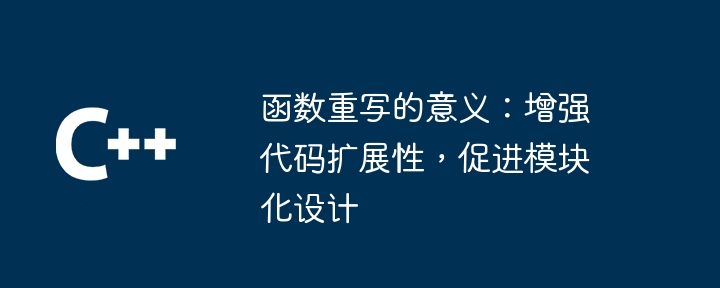
How to carry out code reuse and modular design in Java development
In Java development, code reuse and modular design are very important concepts. Good code reuse and modular design can improve the flexibility, maintainability and scalability of the code. This article will introduce some common technologies and methods in Java development to achieve code reuse and modular design.
- Use object-oriented design principles
Object-oriented design principles are an important cornerstone of Java development. Among them, one of the most important principles is the Single Responsibility Principle (SRP). SRP requires that a class or method should have only one responsibility, which can make the code more concise, more readable, and facilitate code reuse.
Sample code:
public class UserService {
public void createUser(User user) {
// 创建用户的逻辑
}
}
public class User {
private String username;
private String password;
// ...省略其他属性和方法
}In the above example, the UserService class is responsible for creating users, and the User class is responsible for the user's attributes and method. In this way, the UserService class only focuses on the user's creation logic, without paying attention to the user's specific attributes and methods. This is in line with the principles of SRP and is conducive to code reuse and maintainability.
- Using inheritance and interfaces
In Java, inheritance and interfaces are important means to achieve code reuse and modular design. Through inheritance, public code can be extracted into the parent class, and the subclass can inherit the properties and methods of the parent class. The interface defines a series of method specifications. A class that implements an interface needs to provide the methods defined in the interface.
Sample code:
public abstract class Animal {
public abstract void sound();
}
public class Cat extends Animal {
@Override
public void sound() {
System.out.println("喵喵");
}
}
public class Dog extends Animal {
@Override
public void sound() {
System.out.println("汪汪");
}
}In the above example, Animal is an abstract class that defines the sound() method. The Cat and Dog classes respectively inherit the Animal class and implement their respective sound() methods. By using inheritance and abstract classes, code reuse and modular design can be achieved.
- Using composition and dependency injection
Composition and dependency injection are two other commonly used methods of code reuse and modular design. By combining classes, one class can use the functions of other classes, thereby achieving code reuse and modular design. Dependency injection is a method of extracting dependencies from the code, making the code more scalable and flexible.
Sample code:
public class UserRepository {
private DatabaseConnection connection;
public UserRepository(DatabaseConnection connection) {
this.connection = connection;
}
public void save(User user) {
// 保存用户到数据库
}
}
public class DatabaseConnection {
// 连接数据库的实现
}
public class UserService {
private UserRepository userRepository;
public UserService(UserRepository userRepository) {
this.userRepository = userRepository;
}
public void createUser(User user) {
userRepository.save(user);
}
}In the above example, the UserRepository class and the UserService class realize the code duplication through combination. use. Through dependency injection, the UserRepository class depends on the DatabaseConnection class to realize the database connection, and the UserService class depends on the UserRepository class to realize the user's create. In this way, when you need to replace the implementation of a database connection or user store, you only need to modify the corresponding code.
Summary:
Code reuse and modular design are very important concepts in Java development. By using object-oriented design principles, inheritance and interfaces, composition and dependency injection and other technologies and methods, code reuse and modular design can be achieved. This can improve the maintainability, flexibility and scalability of the code, reduce the duplication of code writing, and improve development efficiency. At the same time, reasonable code reuse and modular design can also help reduce code coupling and increase code readability and testability. Therefore, Java developers should actively learn and practice these technologies and methods to improve their development capabilities and code quality.
The above is the detailed content of How to carry out code reuse and modular design in Java development. For more information, please follow other related articles on the PHP Chinese website!
 模板化编程能带来什么好处?May 08, 2024 pm 05:54 PM
模板化编程能带来什么好处?May 08, 2024 pm 05:54 PM模板化编程可提升代码质量,因为它:增强可读性:封装重复代码,使其更易理解。提升可维护性:只需更改模板即可适应数据类型变更。优化效率:编译器生成特定数据类型的优化代码。促进代码复用:创建通用的算法和数据结构,可重复使用。
 C++ 中的泛型算法是如何复用功能的?Jun 05, 2024 pm 07:41 PM
C++ 中的泛型算法是如何复用功能的?Jun 05, 2024 pm 07:41 PMC++泛型算法可复用通用操作,包括:排序算法(如sort)搜索算法(如find)集合操作(如set_difference)转换算法(如transform)使用泛型算法时,需提供输入容器、输出容器(可选)和function对象作为参数。例如,sort算法可用于整数数组排序。自定义比较器可用于按照特定规则排序数据。实战案例中,std::max_element算法可用于查找容器中的最大值,提高代码简洁性和可维护性。
 Java中异常处理的代码复用策略May 01, 2024 am 08:42 AM
Java中异常处理的代码复用策略May 01, 2024 am 08:42 AMJava中异常处理的代码复用策略:捕获并处理常见异常(NullPointerException、IllegalArgumentException、IndexOutOfBoundsException、IOException)。使用try-catch块捕获所有异常。针对特定异常使用单独的catch块。创建自定义异常类以处理自定义异常。使用代码复用简化异常处理,如在文件读取示例中将错误处理封装到readFileWithErrorHandler方法中。
 PHP学习笔记:模块化开发与代码复用Oct 10, 2023 pm 12:58 PM
PHP学习笔记:模块化开发与代码复用Oct 10, 2023 pm 12:58 PMPHP学习笔记:模块化开发与代码复用引言:在软件开发中,模块化开发与代码复用是相当重要的概念。模块化开发可以将复杂的系统分解成可管理的小模块,提高开发效率和代码可维护性;而代码复用则可以减少冗余代码,提高代码的重用性。在PHP开发中,我们可以通过一些技术手段来实现模块化开发和代码复用。本篇文章将介绍一些常用的技术和具体代码示例,帮助读者更好地理解和应用这些概
 Vue开发经验分享:提高开发效率和代码复用的技巧Nov 23, 2023 am 09:53 AM
Vue开发经验分享:提高开发效率和代码复用的技巧Nov 23, 2023 am 09:53 AMVue.js是一种流行的前端框架,被广泛应用于各种Web开发项目中。它的简洁性和高效性使得开发人员能够更快速地构建出功能强大的应用程序。本文将分享一些Vue开发的经验,帮助开发人员提高开发效率和代码复用的技巧。在Vue开发中,有几个关键的方面需要注意。首先是组件的划分和组织。良好的组件划分能够将应用的逻辑清晰地分割成不同的功能模块,并且可以重用
 PHP 设计模式:实现代码复用和扩展性的关键Feb 21, 2024 pm 01:22 PM
PHP 设计模式:实现代码复用和扩展性的关键Feb 21, 2024 pm 01:22 PM在现代软件开发中,创建可扩展、可维护的应用程序至关重要。PHP设计模式提供了一组经过验证的最佳实践,可帮助开发人员实现代码复用和提高扩展性,从而降低复杂性和开发时间。什么是PHP设计模式?设计模式是可重用的编程解决方案,可解决常见的软件设计问题。它们提供统一和通用的方法来组织和结构代码,从而促进代码复用、可扩展性和维护性。SOLID原则php设计模式遵循SOLID原则:S(单一职责):每个类或函数都应负责单一职责。O(开放-封闭):类应针对扩展开放,但针对修改封闭。L(Liskov替换):子类应
 如何进行C++代码的模块化设计?Nov 02, 2023 pm 03:39 PM
如何进行C++代码的模块化设计?Nov 02, 2023 pm 03:39 PM如何进行C++代码的模块化设计?引言:在软件开发过程中,模块化设计是一种重要的编程原则,可以提高代码的可读性、可维护性和可重用性。特别是在C++程序开发中,模块化设计可以帮助开发者将代码分解为独立的功能模块,从而更好地组织和管理代码。本文将介绍如何进行C++代码的模块化设计。一、确定功能模块划分:在C++代码的模块化设计中,首先需要确定程序的功能模块划分。根
 函数重写的意义:增强代码扩展性,促进模块化设计May 03, 2024 pm 01:09 PM
函数重写的意义:增强代码扩展性,促进模块化设计May 03, 2024 pm 01:09 PM函数重写有助于增强代码扩展性,通过创建同一函数的不同版本,允许轻松添加新功能,避免代码修改。它还促进模块化设计,鼓励将代码分解成可重用的代码块,针对不同任务创建专门功能,如解析文本和JSON文件。实战中,函数重写可用于扩展内置函数,例如Python的print()函数,添加前缀消息等自定义行为。


Hot AI Tools

Undresser.AI Undress
AI-powered app for creating realistic nude photos

AI Clothes Remover
Online AI tool for removing clothes from photos.

Undress AI Tool
Undress images for free

Clothoff.io
AI clothes remover

AI Hentai Generator
Generate AI Hentai for free.

Hot Article

Hot Tools

SublimeText3 Mac version
God-level code editing software (SublimeText3)

SAP NetWeaver Server Adapter for Eclipse
Integrate Eclipse with SAP NetWeaver application server.

ZendStudio 13.5.1 Mac
Powerful PHP integrated development environment

mPDF
mPDF is a PHP library that can generate PDF files from UTF-8 encoded HTML. The original author, Ian Back, wrote mPDF to output PDF files "on the fly" from his website and handle different languages. It is slower than original scripts like HTML2FPDF and produces larger files when using Unicode fonts, but supports CSS styles etc. and has a lot of enhancements. Supports almost all languages, including RTL (Arabic and Hebrew) and CJK (Chinese, Japanese and Korean). Supports nested block-level elements (such as P, DIV),

SublimeText3 English version
Recommended: Win version, supports code prompts!






